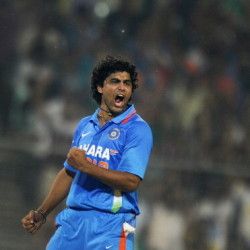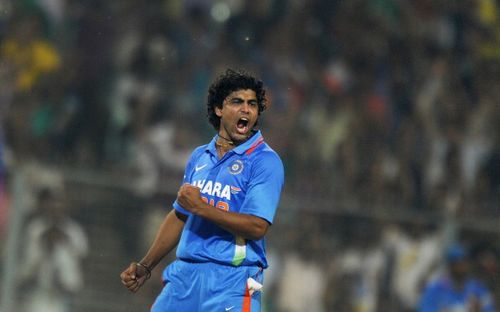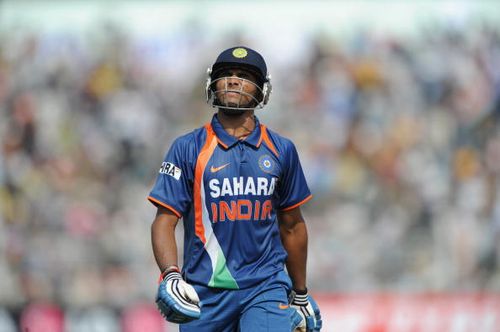
Ravindra Jadeja - Sealing the No.7 door shut

The meaningless banters on ‘Sir’ Ravindra Jadeja have considerably lessened on the internet. The lad from Saurashtra has slowly been redeeming himself in the public’s eyes with noteworthy performances and has transformed into an asset to his skipper and the side.
Jadeja’s predicament is largely based on the undue support bestowed on him by his skipper ahead of better qualified candidates and the fact that he has let the team down on quite a few occasions. He had dissipated umpteen chances of cementing his place on the side and with the potential that he possesses it appears all the more offensive.
There are quite a few instances where he has let the team down owing to his mediocrity and the lack of application. Sample this – in the 2009 T20 World Cup, India had to chase down a tricky 153 run target in a super eight match against England. Coming into bat ahead of an in-form Yuvraj Singh in a crucial run chase, Jadeja (25 off 35 balls) was outrageously defensive and was keen on consolidating his position rather than hitting a few lusty blows, for which he was delegated. It angered the Indian fans to such proportions that he was right away dropped after the World Cup before making one of his many comebacks later in the year.
The 2010 T20 World Cup was no different. India was playing a crucial encounter against West Indies. West Indies were off to a usual flier, thanks to Chris Gayle who was efficacious against the Indian seamers. Ravindra Jadeja was introduced to stem the flow of runs. But what he did stem was the opportunity that India had to make the cut for the semi-finals. He was generous in granting six consecutive sixes to Gayle, which turned the tide of the match in the opponents’ favour, not to mention the crucial catch he put down while fielding at the short fine leg position.
This could all be pardoned but the events that transpired in the 5th one-day match against Australia in 2009 would portray him as the villain forever. Sachin was blasting his way against a fiery Australian team, chasing 351 runs for a victory. Coming in to bat at the fall of Harbhajan’s wicket, Jadeja was listless as he was struggling to come to terms with the pacers. At a crucial juncture, he pressurised Sachin to up the ante, as a result of which Sachin had to depart, consigning the task to the culprit.
“It was certainly one of my best innings, but I would have gladly traded those 175 runs for a victory, it was one of those days when nothing seemed to be out of place. I was able to execute my strokes well. Our middle order failed, but Suresh Raina batted fluently. We had a good partnership of 137. Suresh was caught behind at 299 in the 43rd over. Harbhajan Singh fell soon after, to make it 300/6, but I believed we were very much in control. It was a question of hanging in there, running well and ensuring that bad balls were dealt with harshly. We were only 19 away when I tried to lift (Clint) McKay over short fine-leg, only to be caught by (Nathan) Hauritz. It was a huge disappointment. The lower order tried hard, but more wickets fell, and we fell short by three runs.” – Sachin Tendulkar.
The dejection was evident in Sachin’s statement as he still regrets the incompetence of the ‘lower-middle order batsmen’ who offered the match to the opposition on a platter after coming so close to victory. Jadeja was the man behind the scene as he let the match slip after the Master’s brilliance and his followers would never forgive him for disappointing their idol for an eternity.

In spite of all the blasphemies, there is something queer and compelling about him that merits his selection time and again. Though the critics have been baying for his blood, he has seldom been perturbed by all the accusations, putting his head down and concentrating on the job at hand.
Jadeja’s domestic records are ones to be envied. In the year 2011, he scored his maiden triple century in the four-day format. Scoring a triple century is no child’s play and it can only be achieved with talent and temperament which Jadeja seemed to possess without a doubt. He followed it up with twin triple-tons in the next season which urged the critics to sit up and take notice of the youngster’s talent. It isn’t easy to score three triple centuries and only a handful of talented cricketers have achieved that celeb status. He rose to prominence with his all-round show in the Ranji trophy which merited him a Test match berth.
The IPL’s ‘million-dollar-baby’ has been in the news for quite the wrong reasons in the past. Having been snapped up by the Chennai Super Kings for a mammoth two million figure, Jadeja seldom lived up to the expectations and the money invested. He was mediocre as an all-rounder for Chennai. Two million dollars were considered wasted. Period.
The resurgence of his career arrived in the one-day series in England in 2011. The seniors were out with injuries which provided Jadeja with a chance to stake his claim in the Indian middle-order. Though India were white-washed, Jadeja came up with some critical performances to justify his place in the side. But the script was undone in Australia as he proved a liability with both the bat and the ball in the CB series when David Hussey took him to the cleaners on more than one occasion.
He was thrown back into the domestic circuit again, and Jadeja answered with the triple centuries. The selectors found it hard to ignore him, which paved the way for his Test debut. He failed once again with the bat in his first Test, but was quick on the field and more than handy with the ball which provided him with a berth in the one-day side.
“The day a legend is born is the day when one understands his true potential.”
 The one-day series against England was indeed a saving grace for him and the transformation from a mediocre all-rounder to an irreplaceable asset commenced. At Kochi, in the 2nd ODI, Jadeja rose up to the occasion to hit a whirlwind 61 off just 37 balls to team up with Dhoni and put up a more than challenging 285 on board. It was the turning point of his career as he proved his critics that he could indeed be the quintessential lower middle order batsman which India needed. It was a visual treat as Jadeja thrashed the England bowlers to all parts of the park and he displayed a rare sense of belonging at that stage. He followed it up with some crucial wickets in the series to prove that he is here to stay.
The one-day series against England was indeed a saving grace for him and the transformation from a mediocre all-rounder to an irreplaceable asset commenced. At Kochi, in the 2nd ODI, Jadeja rose up to the occasion to hit a whirlwind 61 off just 37 balls to team up with Dhoni and put up a more than challenging 285 on board. It was the turning point of his career as he proved his critics that he could indeed be the quintessential lower middle order batsman which India needed. It was a visual treat as Jadeja thrashed the England bowlers to all parts of the park and he displayed a rare sense of belonging at that stage. He followed it up with some crucial wickets in the series to prove that he is here to stay.
His form in the England series ensured his berth in the current Border-Gavaskar trophy. He has picked up 11 wickets in the two Test matches he has played, not to mention his utility as a fielder who patrols the inner circle with prowess. His fielding has been a telling attribute as India boasts a poor history of producing fielders of good standards. He stands out from the rest of the players in this aspect and discussing about his fielding, one cannot forget the run-out of a well-set Ricky Ponting in the 4th one-day against Australia in 2009 which tilted the momentum in our favour.
The only grey area is his temperament and consistency. He has found wanting in those aspects in the past, yet he has shown the intent to turn a new leaf and that promise is visible in his performances. He has a long way to go as a cricketer, but he could well bridge the gap between the batsmen and the bowlers in the Indian line-up. His abilities would be handy in sub-continent conditions. With the right amount of temperament and application, he could well be the answer to our prayers of an all-rounder.
The interesting aspect in Jadeja’s career is that he has never given up after a failure. He was on the verge of a World Cup berth before poor form shunted him aside. But the attitude to bounce back has kept him in the hunt all along since the common belief is:
“Winners don’t quit, they always try one more time after every failure!”